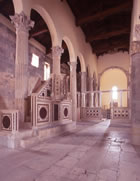 The history of medieval art in Abruzzo coincides with the monastic religious architecture. The history of medieval art in Abruzzo coincides with the monastic religious architecture.
The Benedictine expansion in this region began with the arrival of monks coming from the Montecassino, S. Vincenzo al Volturno and Farfa monasteries. Later on, with the arrival of the Franks, the Benedictines gained power and started the construction of local (autochthonous) abbeys such as S. Liberatore a Maiella and S. Clemente a Casauria.
Several buildings were constructed in quite impracticable places, but safe and well-suited to self defense from probable aggressors and naturally suited to monastic life based on the well known motto ora et labora.
| 












